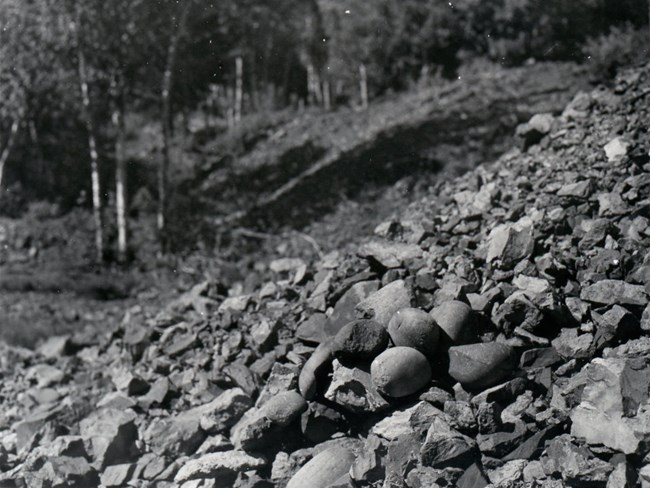Last updated: May 28, 2024
Article
Archaeological History of Isle Royale and Ancient Copper Mining
Archaeological History of Isle Royale
The cultural historical framework used to organize the Isle Royale's archaeological history is consistent with nomenclature employed in the northern tier of the Upper Great Lakes states and adjacent provinces. Cultural stages are divided into substages or phases that represent episodes in the cultural evolution of the historic Native Americans. Isle Royale's prehistoric record began about 4,500 years ago, in the Archaic stage, which continued up to around 100 BCE when pottery was introduced. It was during the Archaic stage that copper mining and working began in earnest, although associated artifacts and habitation sites are only now being identified.
The subsequent Initial Woodland substage is known from its distinctive ceramics related to coeval or somewhat earlier Middle Woodland developments to the south. Laurel culture (Wilford 1941), identified by its distinctive ceramics, has a geographical range from the northern plains across the Superior basin. Laurel dates broadly from about 1,000 BCE to CE 600 when it was gradually supplanted by or evolves into the Terminal Woodland substage. Laurel groups came to Isle Royale, camped, and mined copper; but little of a specific nature can be said of them, owing to the almost universal mixing of Initial and Terminal Woodland components at archaeological sites.
The Terminal Woodland substage, dating from ca. CE 600 to contact with Europeans around the middle of the seventeenth century, is made more complex by the proliferation of stylistic variability, reflecting an ongoing process of local group development. Stone tools, the primary artifacts by which preceramic cultures are classified, assume a homogeneity in form that is interrupted only by the introduction of the bow and arrow, ca. CE 900-1000, marked by the appearance of small triangular arrow points. Ceramics, on the other hand, trace the subtle undulations of cultural interaction across the Upper Great Lakes. Nearly all Great Lakes archaeologists and ethnohistorians comment on the puzzling heterogeneity of ceramics on Terminal Woodland sites. Indeed, the image one derives to account for this archaeological phenomenon is one of permeable territories, constant exchange or trade, and high mobility of groups.
The major Terminal Woodland archaeological cultures represented on Isle Royale sites suggest that groups journeyed to the island from a widespread area that encompassed the entire Lake Superior basin. Included are the Straits of Mackinac sequence from the Juntunen site, the Lakes phase and its cognates from northern Wisconsin, Blackduck culture, Selkirk composite, and Wanikan culture from the rice district of northern Minnesota and adjacent areas of Ontario and Manitoba, and the Huron-Petun from northern Lake Huron.

National Visual Inventory Cards 50-545
Ancient Copper Mining
Copper mining on Isle Royale is no recent thing--in fact it has spanned a period of more than 4,500 years. When man first arrived in the New World, perhaps 15,000 to 20,000 years ago, Isle Royale was still covered with thick glacial ice. By the time the ice receded from the Lake Superior Basin and Isle Royale rose above the waters of the lake about 10,000 years ago, Indians already had begun to occupy parts of the Upper Great Lakes.
It will never be known when the first man ventured out across Lake Superior to Isle Royale, but by 2,500 BCE or shortly thereafter, North American Indians began to exploit the pure copper deposits that were exposed on the surface of the island. Archeologists feel that the Indians may not have deliberately prospected for copper, at least at first, but in the course of their travels about the island, they would watch for nuggets and veins of the bright metal. Eventually a method was developed of extracting the raw copper from the bedrock by beating it free with rounded, hand-held beach cobbles. Thus, numerous pits were dug in the most productive locations on the island, especially along Minong Ridge. Recent archeological excavations have uncoverd large numbers of hammer-stones from the ancient mines which are now filled in by soil and covered with vegetation.
More than 1,000 pits attributed to the Indians have been located on Isle Royale, but since the activity covered a period of at least 1,500 years, there is no basis for suggesting any highly organized efforts to procure the copper. Rather, the mining probably was pursued in the course of an annual round of hunting, fishing, and collecting berries and plants. The copper itself was cold-hammered into knives, points, and a variety of ornaments, either on Isle Royale or taken to the mainland and then worked. Artifacts of Lake Superior copper ultimately made their way to the southern Lake States and New England. Unfortunately, very little is known about the way of life of these earliest miners, since no habitation sites from the mining period have been located on Isle Royale.
